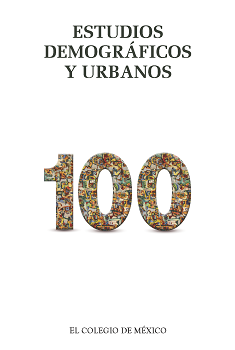Aproximación a curvas de mortalidad a través de una propuesta no paramétrica: el caso del modelo de Heligman y Pollard
Publicado 2018-12-10
Palabras clave
- modelo de Heligman y Pollard,
- suavidad,
- parámetro de suavizamiento,
- tendencias,
- curva de mortalidad
- mínimos cuadrados generalizados ...Más
Cómo citar
-
Resumen2906
-
PDF (español)664
-
En línea (español)974
Descargas
Derechos de autor 2018 Estudios Demográficos y Urbanos

Esta obra está bajo una licencia internacional Creative Commons Atribución-NoComercial-SinDerivadas 4.0.
Métrica
Resumen
Se propone un método no paramétrico para aproximar curvas de mortalidad con énfasis en aquellas generadas a través del modelo de Heligman y Pollard (HP), donde mediante funciones de pérdida se suaviza de manera controlada, tal que la tendencia de la mortalidad observada se aproxime lo más posible a la curva de mortalidad producida por el modelo de HP. Por medio de varias aproximaciones, se observa un mejor ajuste en la mortalidad masculina sobre la femenina y más aún a partir de los 12 años de edad, con lo que se proporciona un rango de referencia para la selección de parámetros de suavizamiento para aproximar con esta perspectiva a aquellas curvas de mortalidad que se obtendrían tras aplicar el modelo HP.
Referencias
- Alba, E. y Gómez, S. (2012). A Bayesian approach to the Hodrick-Prescott filter. Realidad, Datos y Espacio. Revista Internacional de Estadística y Geografía, 3(3), 32-47. Recuperado de http://www.inegi.org.mx/rde/RDE_07/Doctos/RDE_07_opt.pdf
- Carriere, J. F. (1992). Parametric models for life tables. Transactions of Society of Actuaries, 44, 77-99. Recuperado de https://www.researchgate.net/publication/265022199_Parametric_models_for_life_tables
- Congdon, P. (1993). Statistical graduation in local demographic analysis and projection. Journal of the Royal Statistical Society. Series A, 156(2), 237-270. Recuperado de http://www.jstor.org/stable/pdf/2982731.pdf DOI: https://doi.org/10.2307/2982731
- Cortés-Toto, D., Guerrero, V. M. y Reyes, H. (2017). Trend smoothness achieved by penalized least squares with the smoothing parameter chosen by optimality criteria. Communications in Statistics-Simulation and Computation, 46(2), 1492-1507. Recuperado de https://www.tandfonline.com/doi/full/10.1080/03610918.2015.1005236 DOI: https://doi.org/10.1080/03610918.2015.1005236
- Debón, A., Montes, F. y Sala, R. (2006). A comparison of nonparametric methods in the graduation of mortality: Application to data from the Valencia region (Spain). International Statistical Review, 74(2), 215-233. Recuperado de https://www.jstor.org/stable/25472704?seq=1#page_scan_tab_contents DOI: https://doi.org/10.1111/j.1751-5823.2006.tb00171.x
- Dellaportas, P., Smith, A. y Stavropoulos, P. (2001). Bayesian analysis of mortality data. Journal of the Royal Statistical Society A, 164, 275-291. Recuperado de http://csyue.nccu.edu.tw/ch/Bayesian%20analysis%20of%20mortality%20data.pdf DOI: https://doi.org/10.1111/1467-985X.00202
- De Moivre, A. (1725). In Annuities on Lives, Londres: H. & S.
- Felipe, A., Guillen, M. y Pérez-Marín, A. (2002). Recent mortality trends in the Spanish population. British Actuarial Journal, 8(4), 757-786. Recuperado de https://www.jstor.org/stable/41141561?seq=1#page_scan_tab_contents DOI: https://doi.org/10.1017/S1357321700003901
- Forfar, D. (2006). Mortality laws. Encyclopedia of Actuarial Science 2. Edimburgo, Escocia: Wiley.
- Gompertz, B. (1825). On the nature of the function expressive of the law of human mortality, and on a new mode of determining the value of life contingencies. Philosophical Transactions of Royal Society of London, 115(1825), 513-583. Recuperado de https://www.medicine.mcgill.ca/epidemiology/hanley/c609/material/Gompertz-1825.pdf DOI: https://doi.org/10.1098/rstl.1825.0026
- Gompertz, B. (1860). On one uniform law of mortality from birth to extreme old age and on the law of sickness. Journal of the Institute of Actuaries, 16(5), 329-344. Recuperado de https://doi.org/10.1017/S204616740004369X DOI: https://doi.org/10.1017/S204616740004369X
- Gompertz, B. (1862). A supplement to two papers published in the Transactions of the Royal Society, “On the science connected with human mortality;” the one published in 1820, and the other in 1825. Philosophical Transactions of Royal Society (Series A), 152, 511-559. Recuperado de http://rstl.royalsocietypublishing.org/content/152/511.full.pdf+html DOI: https://doi.org/10.1098/rstl.1862.0026
- Guerrero, V. M. (2008). Estimating trends with percentage of smoothness chosen by the user. International Statistical Review, 76(2), 187-202. Recuperado de https://www.jstor.org/stable/27919611?seq=1#page_scan_tab_contents DOI: https://doi.org/10.1111/j.1751-5823.2008.00047.x
- Guerrero, V. M. y Silva, E. (2015). Smoothing a time series by segments of the data range. Communications in Statistics - Theory and Methods, 44(21), 4568-4585. Recuperado de https://www.tandfonline.com/doi/full/10.1080/03610926.2014.901372 DOI: https://doi.org/10.1080/03610926.2014.901372
- Hartmann, M. (1987). Past and recent attempts to model mortality at all ages. Journal of Official Statistics, 3(1), 19-36. Recuperado de https://www.ncbi.nlm.nih.gov/pubmed/12342229
- Heligman, L. y Pollard, J. (1980). The age pattern of mortality. Journal of the Institute of Actuaries, 107(1), 49-80. Recuperado de https://doi.org/10.1017/S0020268100040257 DOI: https://doi.org/10.1017/S0020268100040257
- Hodrick, R. y Prescott, E. (1997). Postwar U.S. business cycles: An empirical investigation. Journal Money, Credit Bank, 29(1), 1-16. Recuperado de https://www0.gsb.columbia.edu/faculty/rhodrick/prescott-hodrick1997.pdf DOI: https://doi.org/10.2307/2953682
- Jos, I. (2014). Estimating the mortality of the Philippines and some southeast Asian countries using the Heligman-Pollard model. Ponencia presentada en el DSLU Research Congress 2014, De La Salle University, Manila Filipinas, 6 a 8 de marzo. Recuperado de http://www.dlsu.edu.ph/conferences/dlsu_research_congress/2014/_pdf/proceedings/FNH-II-017-ft.pdf
- Irnawaty, R. (2008). Expanding an abridged life table using the Heligman-Pollard model. Matematika, 24(1), 1-10. Recuperado de http://citeseerx.ist.psu.edu/viewdoc/download?doi=10.1.1.496.1577&rep=rep1&type=pdf
- Kaiser, R. y Maravall, A. (2001). Measuring business cycles in economic time series. Lecture Notes in Statistics, 154, Nueva York: Springer-Verlag. DOI: https://doi.org/10.1007/978-1-4613-0129-5
- Knorr, F. (1984). Multidimensional Whittaker-Henderson graduation. Transactions of Society of Actuaries, 36, 213-255. Recuperado de https://www.soa.org/library/research/transactions-of-society-of-actuaries/1984/january/tsa84v3611.pdf
- Kostaki, A. (1991). The Heligman-Pollard formula as a tool for expanding an abridged life table. Journal of Official Statistics, 7(3), 311-323. Recuperado de http://www.jos.nu/Articles/abstract.asp?article=73311
- Makeham, W. (1867). On the law of mortality. Journal of the Institute of Actuaries, 13(6), 325-358. Recuperado de https://doi.org/10.1017/S2046166600003238 DOI: https://doi.org/10.1017/S2046166600003238
- Makeham, W. (1889). On the further development of Gompertz’s law. Journal of the Institute of Actuaries, 28(2), 152-159. Recuperado de https://www.jstor.org/stable/41136363?seq=1#page_scan_tab_contents DOI: https://doi.org/10.1017/S0020268100049192
- Mendoza, M., Madrigal, A. y Gutiérrez-Peña, E. (2001). Predictive mortality graduation and the value at risk: A Bayesian approach. Documento de trabajo DE-C01.5. Ciudad de México: ITAM.
- Nocon, A. y Scott, W. F. (2012). An extension of the Whittaker-Henderson method of graduation. Scandinavian Actuarial Journal, 1, 70-79. Recuperado de https://www.researchgate.net/publication/233130363_An_extension_of_the_Whittaker-Henderson_method_of_graduation DOI: https://doi.org/10.1080/03461238.2010.534257
- Ovin, A. y Silva, E. (2016a). Measuring the induced smoothness in the application of the Heligman and Pollard (HP) model with a smoothness index. Ponencia presentada en el 9th World Congress in Probability and Statistics, Toronto, Ontario, Canadá.
- Ovin, A. y Silva, E. (2016b). Aproximación del modelo de Heligman y Pollard a través de una propuesta no paramétrica. Ponencia presentada en la XIII Reunión Nacional de Investigación Demográfica en México, “Dinámicas de población y desigualdad”, Universidad Nacional Autónoma de México. México.
- Sharrow, D., Clark, S., Collinson, M., Kahn, K. y Tollman, S. (2013). The age pattern of increases in mortality affected by HIV: Bayesian fit of the Heligman-Pollard model to data from the Agincourt HDSS field site in rural northeast South Africa. Demographic Research, 29(39), 1039-1096. Recuperado de https://www.demographic-research.org/volumes/vol29/39/default.htm DOI: https://doi.org/10.4054/DemRes.2013.29.39
- Syahmi, M., Md Yusuf, M., Suhaylah, Y. y Yazis, M. (2015). Expanding abridge life table by using Heligman Pollard method: Malaysian experience 2010-2013. International Journal of Business and Social Science, 6(7), 133-138. Recuperado de http://ijbssnet.com/journals/Vol_6_No_7_July_2015/15.pdf
- Thiele, T. (1871). On a mathematical formula to express the rate of mortality throughout the whole of life, tested by a series of observations made use of by the Danish life insurance company of 1871. Journal of the Institute of Actuaries and Assure Magazine, 16(5), 313-329. Recuperado de https://www.jstor.org/stable/41135308?seq=1#page_scan_tab_contents DOI: https://doi.org/10.1017/S2046167400043688
- Vargas, K. (2014). Cálculo de la edad máxima estimada de la tabla de mortalidad mexicana CNSF 2000-I, su importancia y sus aplicaciones. Trabajo presentado para el XXI Premio de Investigación sobre Seguros y Fianzas 2014 “Antonio Minzoni Consorti”, Comisión Nacional de Seguros y Fianzas, México.
- Whittaker, E. (1923). On a new method of graduation. Proceedings of the Edinburgh Mathematical Society, 41, 63-75. Recuperado de https://www.cambridge.org/core/services/aop-cambridge-core/content/view/744E6CBD93804DA4DF7CAC50507FA7BB/S0013091500077853a.pdf/on_a_new_method_of_graduation.pdf DOI: https://doi.org/10.1017/S0013091500077853
- Yuen, K. (1997). Comments on some parametric models for mortality tables. Journal of Actuarial Practice, 5(2), 253-265. Recuperado de https://digitalcommons.unl.edu/cgi/viewcontent.cgi?referer=https://www.google.com.mx/&httpsredir=1&article=1105&context=joap


